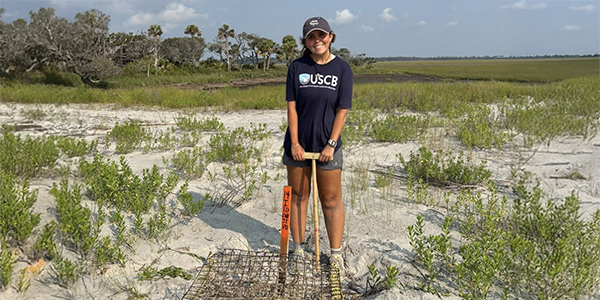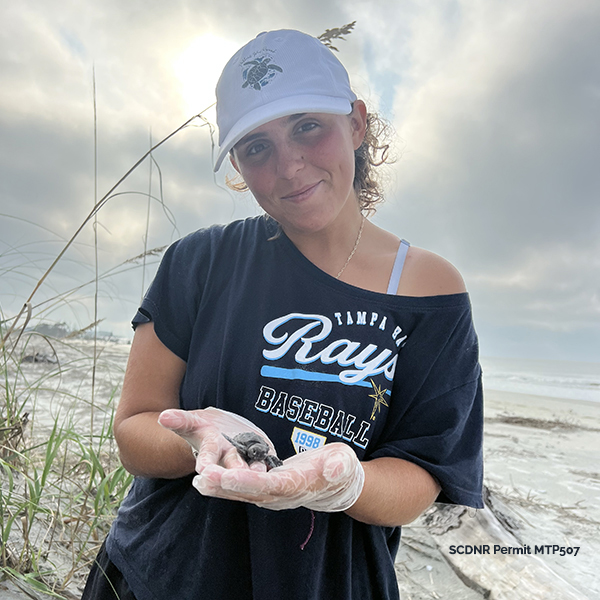Internship Q&A: Taylor DeSilva - Marine Biology

What did you do?
During this internship, I was responsible for a range of field and data-collection tasks throughout the sea turtle nesting season on both Pritchards Island and Little Capers Island. At the start of the season, I participated in daily beach surveys to locate and identify tracks left by nesting females. For each track, I recorded measurements such as track width, determined the species based on track patterns, and searched for signs of a nest. When a nest was located, I carefully identified the egg chamber and evaluated whether relocation was necessary, then carried out the relocation if required. I also collected GPS coordinates of each nest and obtained genetic egg samples for the Department of Natural Resources. Throughout the season, I monitored all documented nests for signs of predation, disturbance, or tidal wash overs. As hatching season approached, I watched for indicators such as craters or hatchling tracks and reported any changes in the nest that would indicate it had hatched or was close to hatching. After a nest had hatched, I assisted with nest inventories, excavating each site to count hatched and unhatched eggs, document live or deceased hatchlings, and record all findings for official reports.
Where did you live?
I was able to stay on the Beaufort campus in the dorms!
What's one surprising thing you learned?
I was surprised to learn how determined and resilient hatchlings are as they make their way from the nest to the ocean. Even though they are tiny and vulnerable, they instinctively head toward the brightest natural light over the water and can travel impressive distances almost immediately after emerging. Watching that instinct in action and seeing how quickly they begin their journey was both fascinating and inspiring!
Why did you intern there?
I chose this internship because of my strong commitment to conservation. Most of the nesting mothers we saw this season are loggerhead turtles, a threatened species, and contributing to the success of their nests felt like a meaningful way to support their protection. Assisting with hatch success and witnessing hatchlings reach the ocean gave me a tangible sense of contributing to the species’ recovery. I also value fieldwork and hands-on experience, and this internship allowed me to combine those interests with conservation in a direct and impactful way!
How did USCB help you get this internship?
Without the support of USCB and Dr. Kim Ritchie, I would not have had the opportunity to participate in such an incredible internship. Dr. Ritchie's guidance and encouragement was instrumental in helping me identify and secure this position, as well as in preparing me with the knowledge and skills needed to succeed in the field. The university provided more than just an academic foundation, it offered the resources, connections, and encouragement that made this experience possible. Through coursework in marine biology, I gained a strong understanding of coastal ecosystems and conservation methods, which prepared me to handle the scientific and technical aspects of fieldwork. USCB created an environment where I could apply classroom knowledge directly to real-world conservation efforts. This comprehensive support allowed me not only to secure the internship but to excel in it, turning my passion for sea turtle conservation into practical experience that will shape my future career. Dr. Ritchie also created an environment where I could grow as a student and as a future conservation professional. This experience has not only strengthened my career goals but also deepened my appreciation for the mentorship and resources available through the university.
Why do you think an internship is important?
I believe that an internship is important because it bridges the gap between classroom learning and real world application. It provides hands on experience, allowing you as a student to practice the skills and concepts you’ve studied while developing new ones that can only be gained in the field. Internships also help build professional networks, introduce you to potential mentors, and give you a clearer sense of what day-to-day work in a chosen career may actually look like. For conservation work in particular, an internship offers direct exposure to field research, data collection, and the challenges of protecting endangered species experience that can’t be fully replicated in a lab or lecture. This practical training not only strengthens a résumé or graduate school application but also builds confidence and a deeper understanding of how to contribute effectively to the field!
What was the weirdest and/or most fun thing that has happened to you on the job?
One of the strangest, and definitely most memorable, things that happened to me during the internship was during a nest relocation. I was carefully relocating a turtle nest when suddenly, I realized I wasn’t alone… a Least Tern (I believe) apparently thought I was a serious threat to her eggs. She began dive-bombing me nonstop, swooping down so close to my head that I honestly thought she might knock me over (or attempt to). At one point, I swear she even made contact with my head! I had to focus not only on safely relocating the turtle nest but also on tiptoeing around in order to insure I wasn't accidentally too close to her eggs. It was equal parts terrifying, hilarious, and humbling, definitely one of those “only in the field” experiences.
On the other hand, the best days were always when we had live hatchlings to release into the ocean. There’s something incredibly rewarding and honestly a little magical about watching teeny tiny turtles make that first scramble toward the waves, all instinct and determination. Those moments made all the early mornings, long walks, and dive-bombing birds completely worth it.

-USCB-
JJ10/2/25